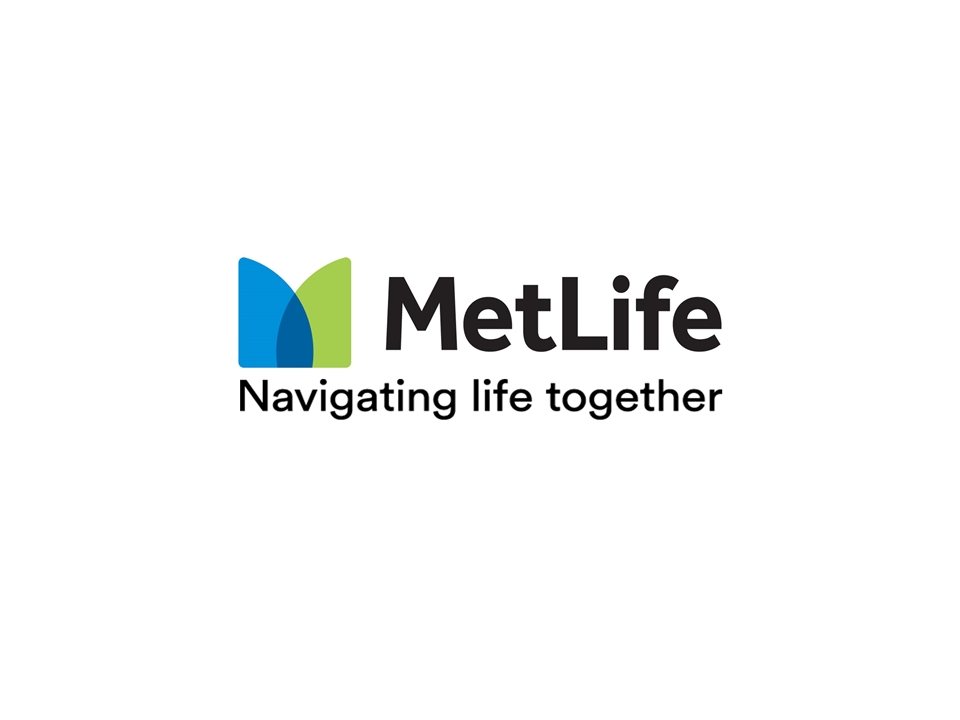Attached files
| file | filename |
|---|---|
| 8-K - 8-K - METLIFE INC | d480379d8k.htm |

MetLife 2017 Outlook Call December 15, 2017 Exhibit 99.1

Introduction John A. Hall Senior Vice President, Investor Relations
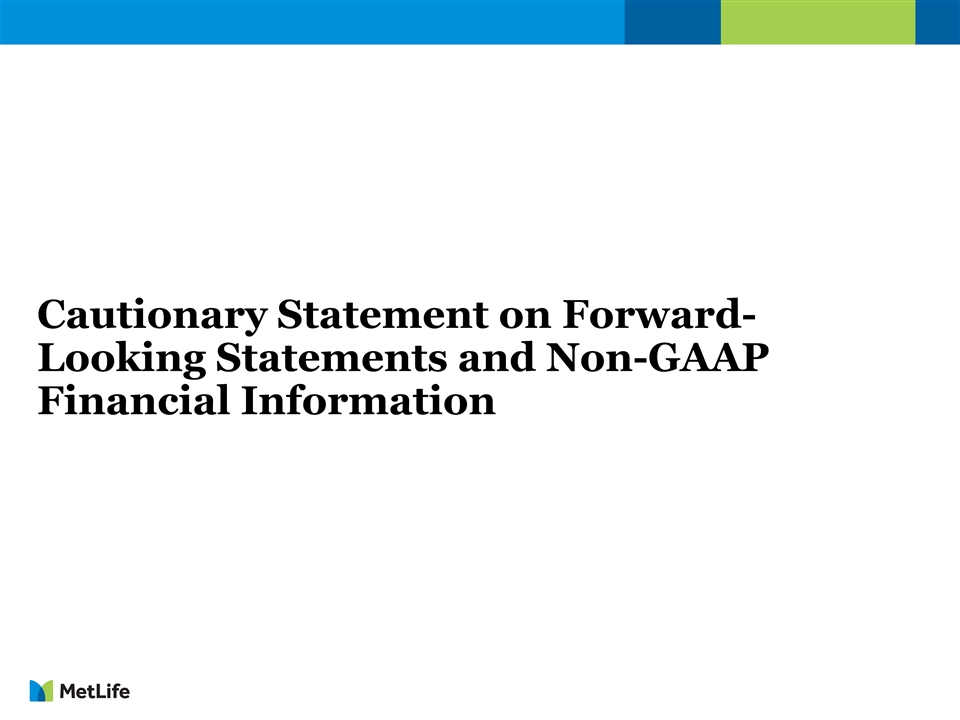
Cautionary Statement on Forward-Looking Statements and Non-GAAP Financial Information
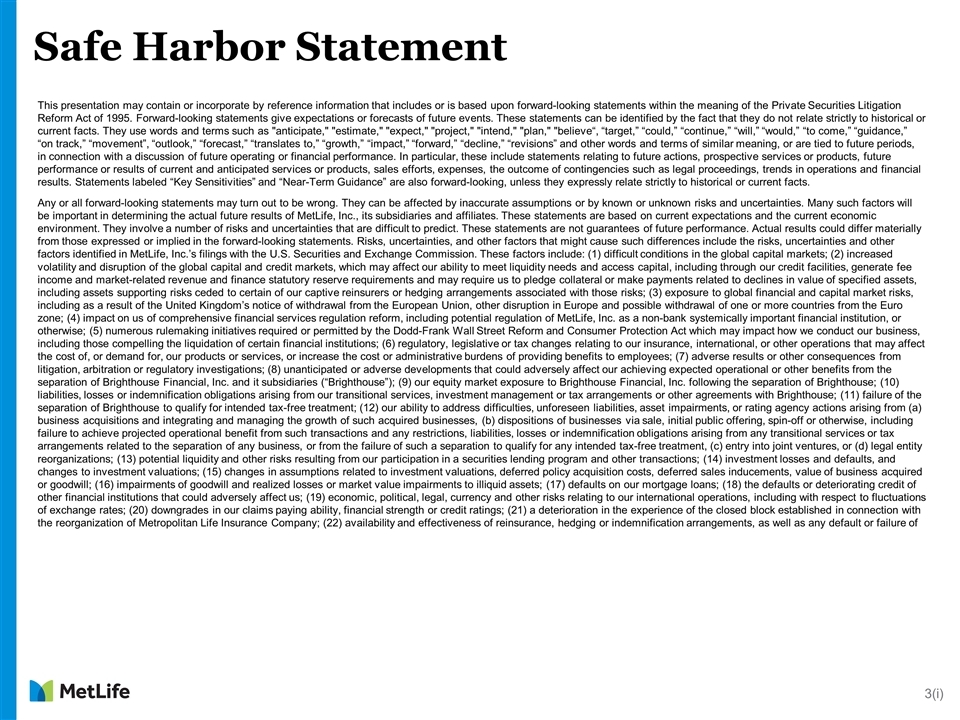
Safe Harbor Statement This presentation may contain or incorporate by reference information that includes or is based upon forward-looking statements within the meaning of the Private Securities Litigation Reform Act of 1995. Forward-looking statements give expectations or forecasts of future events. These statements can be identified by the fact that they do not relate strictly to historical or current facts. They use words and terms such as "anticipate," "estimate," "expect," "project," "intend," "plan," "believe“, “target,” “could,” “continue,” “will,” “would,” “to come,” “guidance,” “on track,” “movement”, “outlook,” “forecast,” “translates to,” “growth,” “impact,” “forward,” “decline,” “revisions” and other words and terms of similar meaning, or are tied to future periods, in connection with a discussion of future operating or financial performance. In particular, these include statements relating to future actions, prospective services or products, future performance or results of current and anticipated services or products, sales efforts, expenses, the outcome of contingencies such as legal proceedings, trends in operations and financial results. Statements labeled “Key Sensitivities” and “Near-Term Guidance” are also forward-looking, unless they expressly relate strictly to historical or current facts. Any or all forward-looking statements may turn out to be wrong. They can be affected by inaccurate assumptions or by known or unknown risks and uncertainties. Many such factors will be important in determining the actual future results of MetLife, Inc., its subsidiaries and affiliates. These statements are based on current expectations and the current economic environment. They involve a number of risks and uncertainties that are difficult to predict. These statements are not guarantees of future performance. Actual results could differ materially from those expressed or implied in the forward-looking statements. Risks, uncertainties, and other factors that might cause such differences include the risks, uncertainties and other factors identified in MetLife, Inc.’s filings with the U.S. Securities and Exchange Commission. These factors include: (1) difficult conditions in the global capital markets; (2) increased volatility and disruption of the global capital and credit markets, which may affect our ability to meet liquidity needs and access capital, including through our credit facilities, generate fee income and market-related revenue and finance statutory reserve requirements and may require us to pledge collateral or make payments related to declines in value of specified assets, including assets supporting risks ceded to certain of our captive reinsurers or hedging arrangements associated with those risks; (3) exposure to global financial and capital market risks, including as a result of the United Kingdom’s notice of withdrawal from the European Union, other disruption in Europe and possible withdrawal of one or more countries from the Euro zone; (4) impact on us of comprehensive financial services regulation reform, including potential regulation of MetLife, Inc. as a non-bank systemically important financial institution, or otherwise; (5) numerous rulemaking initiatives required or permitted by the Dodd-Frank Wall Street Reform and Consumer Protection Act which may impact how we conduct our business, including those compelling the liquidation of certain financial institutions; (6) regulatory, legislative or tax changes relating to our insurance, international, or other operations that may affect the cost of, or demand for, our products or services, or increase the cost or administrative burdens of providing benefits to employees; (7) adverse results or other consequences from litigation, arbitration or regulatory investigations; (8) unanticipated or adverse developments that could adversely affect our achieving expected operational or other benefits from the separation of Brighthouse Financial, Inc. and it subsidiaries (“Brighthouse”); (9) our equity market exposure to Brighthouse Financial, Inc. following the separation of Brighthouse; (10) liabilities, losses or indemnification obligations arising from our transitional services, investment management or tax arrangements or other agreements with Brighthouse; (11) failure of the separation of Brighthouse to qualify for intended tax-free treatment; (12) our ability to address difficulties, unforeseen liabilities, asset impairments, or rating agency actions arising from (a) business acquisitions and integrating and managing the growth of such acquired businesses, (b) dispositions of businesses via sale, initial public offering, spin-off or otherwise, including failure to achieve projected operational benefit from such transactions and any restrictions, liabilities, losses or indemnification obligations arising from any transitional services or tax arrangements related to the separation of any business, or from the failure of such a separation to qualify for any intended tax-free treatment, (c) entry into joint ventures, or (d) legal entity reorganizations; (13) potential liquidity and other risks resulting from our participation in a securities lending program and other transactions; (14) investment losses and defaults, and changes to investment valuations; (15) changes in assumptions related to investment valuations, deferred policy acquisition costs, deferred sales inducements, value of business acquired or goodwill; (16) impairments of goodwill and realized losses or market value impairments to illiquid assets; (17) defaults on our mortgage loans; (18) the defaults or deteriorating credit of other financial institutions that could adversely affect us; (19) economic, political, legal, currency and other risks relating to our international operations, including with respect to fluctuations of exchange rates; (20) downgrades in our claims paying ability, financial strength or credit ratings; (21) a deterioration in the experience of the closed block established in connection with the reorganization of Metropolitan Life Insurance Company; (22) availability and effectiveness of reinsurance, hedging or indemnification arrangements, as well as any default or failure of 3(i)

Safe Harbor Statement (Continued) counterparties to perform; (23) differences between actual claims experience and underwriting and reserving assumptions; (24) ineffectiveness of risk management policies and procedures; (25) catastrophe losses; (26) increasing cost and limited market capacity for statutory life insurance reserve financings; (27) heightened competition, including with respect to pricing, entry of new competitors, consolidation of distributors, the development of new products by new and existing competitors, and for personnel; (28) exposure to losses related to variable annuity guarantee benefits, including from significant and sustained downturns or extreme volatility in equity markets, reduced interest rates, unanticipated policyholder behavior, mortality or longevity, and any adjustment for nonperformance risk; (29) legal, regulatory and other restrictions affecting MetLife, Inc.’s ability to pay dividends and repurchase common stock; (30) MetLife, Inc.’s and its subsidiary holding companies’ primary reliance, as holding companies, on dividends from subsidiaries to meet free cash flow targets and debt payment obligations and the applicable regulatory restrictions on the ability of the subsidiaries to pay such dividends; (31) the possibility that MetLife, Inc.’s Board of Directors may influence the outcome of stockholder votes through the voting provisions of the MetLife Policyholder Trust; (32) changes in accounting standards, practices and/or policies; (33) increased expenses relating to pension and postretirement benefit plans, as well as health care and other employee benefits; (34) inability to protect our intellectual property rights or claims of infringement of the intellectual property rights of others; (35) difficulties in marketing and distributing products through our distribution channels; (36) provisions of laws and our incorporation documents may delay, deter or prevent takeovers and corporate combinations involving MetLife; (37) the effects of business disruption or economic contraction due to disasters such as terrorist attacks, cyberattacks, other hostilities, or natural catastrophes, including any related impact on the value of our investment portfolio, our disaster recovery systems, cyber- or other information security systems and management continuity planning; (38) any failure to protect the confidentiality of client information; (39) the effectiveness of our programs and practices in avoiding giving our associates incentives to take excessive risks; and (40) other risks and uncertainties described from time to time in MetLife, Inc.’s filings with the U.S. Securities and Exchange Commission. MetLife, Inc. does not undertake any obligation to publicly correct or update any forward-looking statement if MetLife, Inc. later becomes aware that such statement is not likely to be achieved. Please consult any further disclosures MetLife, Inc. makes on related subjects in reports to the U.S. Securities and Exchange Commission. 3(ii)

Explanatory Note on Non-GAAP Financial Information In this presentation, MetLife, Inc. presents certain measures of its performance that are not calculated in accordance with accounting principles generally accepted in the United States of America (“GAAP”). MetLife believes that these non-GAAP financial measures enhance the understanding of MetLife’s performance by highlighting the results of operations and the underlying profitability drivers of the business. The following non-GAAP financial measure should not be viewed as a substitute for the most directly comparable financial measure calculated in accordance with GAAP: Reconciliations of these measures to the most directly comparable GAAP measures are included in this presentation. A reconciliation of these non-GAAP measures to the most directly comparable GAAP measures is not accessible on a forward-looking basis because we believe it is not possible without unreasonable efforts to provide other than a range of net investment gains and losses and net derivative gains and losses, which can fluctuate significantly within or outside the range and from period to period and may have a material impact on net income. MetLife’s definitions of the various non-GAAP and other financial measures discussed in this presentation may differ from those used by other companies: Any references in this presentation (except in this Cautionary Statement on Forward-Looking Statements and Non-GAAP Financial Information) to: should be read as, respectively: (i) operating earnings; (i) operating earnings available to common shareholders; (ii) reported operating earnings; and (ii) operating earnings available to common shareholders; and (iii) baseline operating earnings. (iii) operating earnings available to common shareholders, adjusted for total notable items. 3(iii) Non-GAAP financial measure: Comparable GAAP financial measure: (i) operating earnings available to common shareholders, adjusted for total notable items (i) operating earnings available to common shareholders
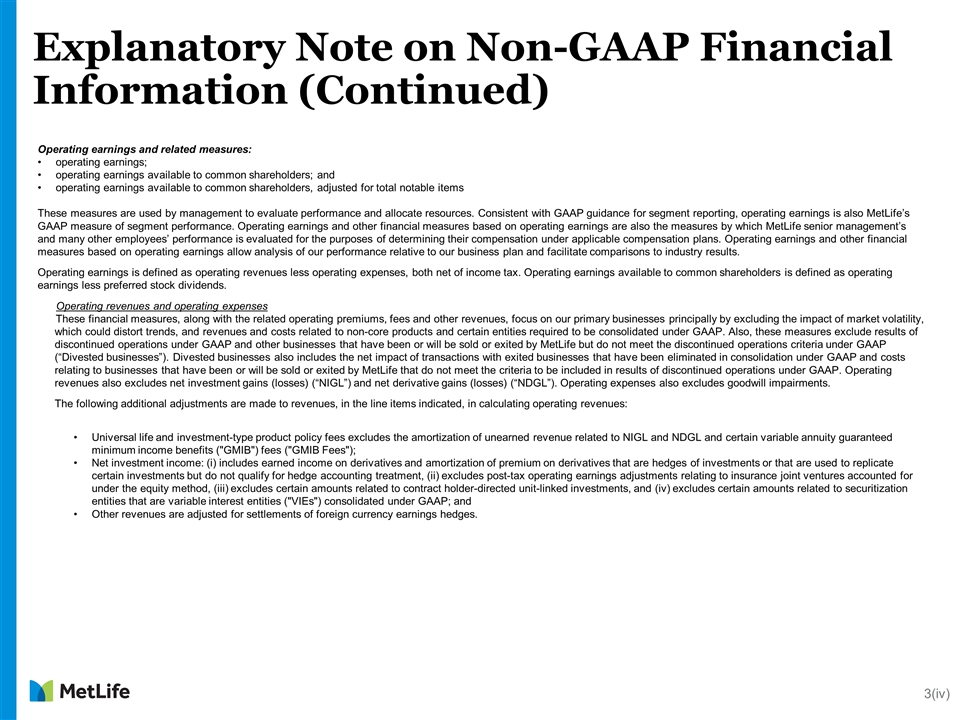
Operating earnings and related measures: operating earnings; operating earnings available to common shareholders; and operating earnings available to common shareholders, adjusted for total notable items These measures are used by management to evaluate performance and allocate resources. Consistent with GAAP guidance for segment reporting, operating earnings is also MetLife’s GAAP measure of segment performance. Operating earnings and other financial measures based on operating earnings are also the measures by which MetLife senior management’s and many other employees’ performance is evaluated for the purposes of determining their compensation under applicable compensation plans. Operating earnings and other financial measures based on operating earnings allow analysis of our performance relative to our business plan and facilitate comparisons to industry results. Operating earnings is defined as operating revenues less operating expenses, both net of income tax. Operating earnings available to common shareholders is defined as operating earnings less preferred stock dividends. Operating revenues and operating expenses These financial measures, along with the related operating premiums, fees and other revenues, focus on our primary businesses principally by excluding the impact of market volatility, which could distort trends, and revenues and costs related to non-core products and certain entities required to be consolidated under GAAP. Also, these measures exclude results of discontinued operations under GAAP and other businesses that have been or will be sold or exited by MetLife but do not meet the discontinued operations criteria under GAAP (“Divested businesses”). Divested businesses also includes the net impact of transactions with exited businesses that have been eliminated in consolidation under GAAP and costs relating to businesses that have been or will be sold or exited by MetLife that do not meet the criteria to be included in results of discontinued operations under GAAP. Operating revenues also excludes net investment gains (losses) (“NIGL”) and net derivative gains (losses) (“NDGL”). Operating expenses also excludes goodwill impairments. The following additional adjustments are made to revenues, in the line items indicated, in calculating operating revenues: Universal life and investment-type product policy fees excludes the amortization of unearned revenue related to NIGL and NDGL and certain variable annuity guaranteed minimum income benefits ("GMIB") fees ("GMIB Fees"); Net investment income: (i) includes earned income on derivatives and amortization of premium on derivatives that are hedges of investments or that are used to replicate certain investments but do not qualify for hedge accounting treatment, (ii) excludes post-tax operating earnings adjustments relating to insurance joint ventures accounted for under the equity method, (iii) excludes certain amounts related to contract holder-directed unit-linked investments, and (iv) excludes certain amounts related to securitization entities that are variable interest entities ("VIEs") consolidated under GAAP; and Other revenues are adjusted for settlements of foreign currency earnings hedges. Explanatory Note on Non-GAAP Financial Information (Continued) 3(iv)
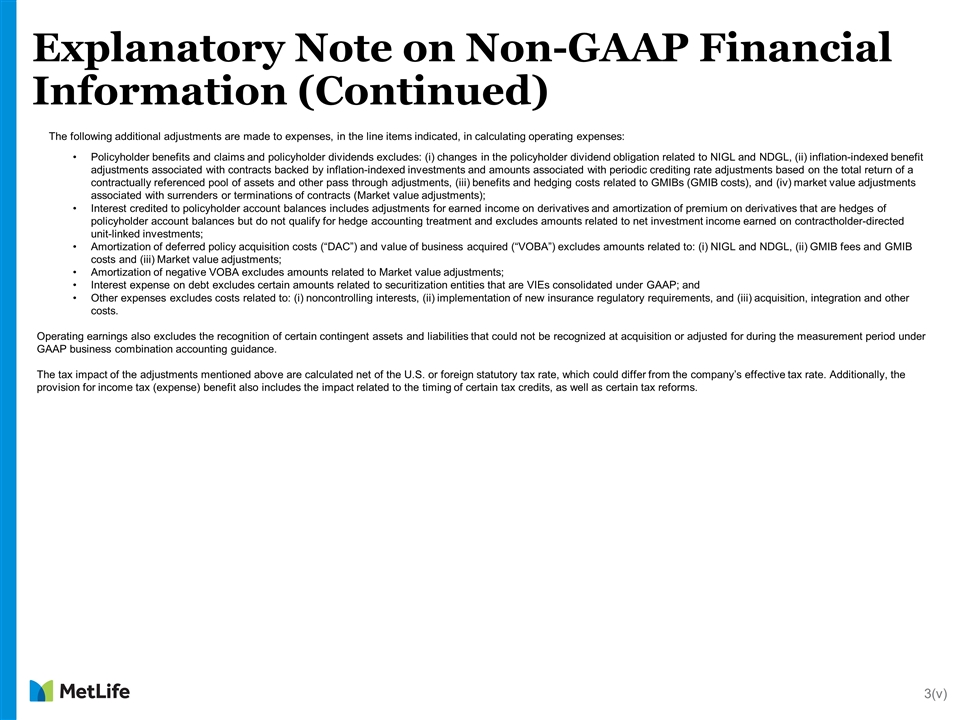
Explanatory Note on Non-GAAP Financial Information (Continued) The following additional adjustments are made to expenses, in the line items indicated, in calculating operating expenses: Policyholder benefits and claims and policyholder dividends excludes: (i) changes in the policyholder dividend obligation related to NIGL and NDGL, (ii) inflation-indexed benefit adjustments associated with contracts backed by inflation-indexed investments and amounts associated with periodic crediting rate adjustments based on the total return of a contractually referenced pool of assets and other pass through adjustments, (iii) benefits and hedging costs related to GMIBs (GMIB costs), and (iv) market value adjustments associated with surrenders or terminations of contracts (Market value adjustments); Interest credited to policyholder account balances includes adjustments for earned income on derivatives and amortization of premium on derivatives that are hedges of policyholder account balances but do not qualify for hedge accounting treatment and excludes amounts related to net investment income earned on contractholder-directed unit-linked investments; Amortization of deferred policy acquisition costs (“DAC”) and value of business acquired (“VOBA”) excludes amounts related to: (i) NIGL and NDGL, (ii) GMIB fees and GMIB costs and (iii) Market value adjustments; Amortization of negative VOBA excludes amounts related to Market value adjustments; Interest expense on debt excludes certain amounts related to securitization entities that are VIEs consolidated under GAAP; and Other expenses excludes costs related to: (i) noncontrolling interests, (ii) implementation of new insurance regulatory requirements, and (iii) acquisition, integration and other costs. Operating earnings also excludes the recognition of certain contingent assets and liabilities that could not be recognized at acquisition or adjusted for during the measurement period under GAAP business combination accounting guidance. The tax impact of the adjustments mentioned above are calculated net of the U.S. or foreign statutory tax rate, which could differ from the company’s effective tax rate. Additionally, the provision for income tax (expense) benefit also includes the impact related to the timing of certain tax credits, as well as certain tax reforms. 3(v)
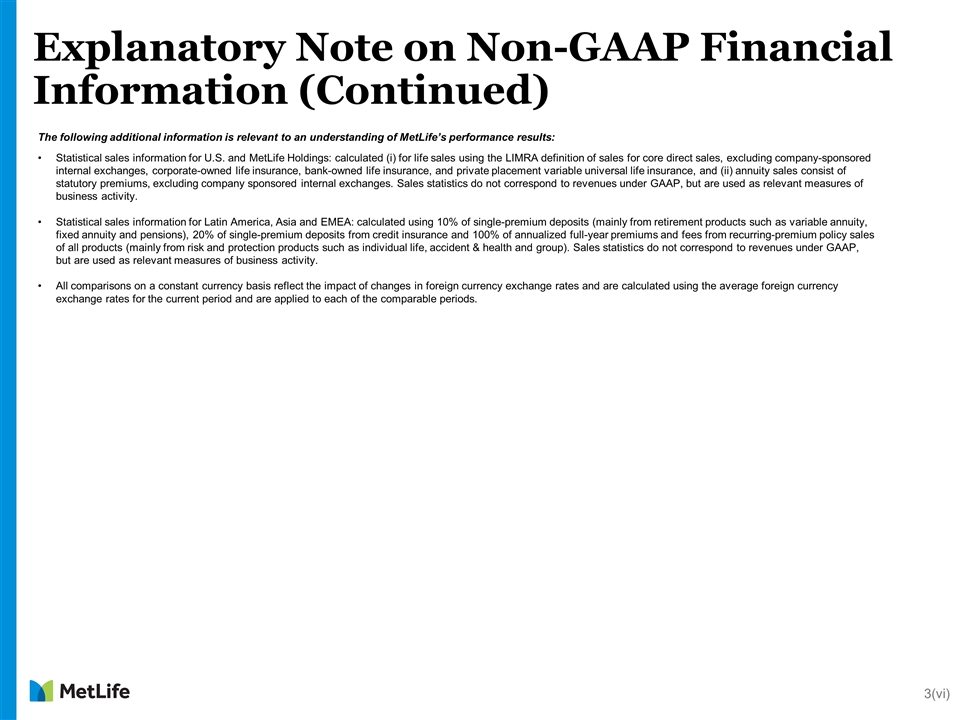
Explanatory Note on Non-GAAP Financial Information (Continued) The following additional information is relevant to an understanding of MetLife’s performance results: Statistical sales information for U.S. and MetLife Holdings: calculated (i) for life sales using the LIMRA definition of sales for core direct sales, excluding company-sponsored internal exchanges, corporate-owned life insurance, bank-owned life insurance, and private placement variable universal life insurance, and (ii) annuity sales consist of statutory premiums, excluding company sponsored internal exchanges. Sales statistics do not correspond to revenues under GAAP, but are used as relevant measures of business activity. Statistical sales information for Latin America, Asia and EMEA: calculated using 10% of single-premium deposits (mainly from retirement products such as variable annuity, fixed annuity and pensions), 20% of single-premium deposits from credit insurance and 100% of annualized full-year premiums and fees from recurring-premium policy sales of all products (mainly from risk and protection products such as individual life, accident & health and group). Sales statistics do not correspond to revenues under GAAP, but are used as relevant measures of business activity. All comparisons on a constant currency basis reflect the impact of changes in foreign currency exchange rates and are calculated using the average foreign currency exchange rates for the current period and are applied to each of the comparable periods. 3(vi)
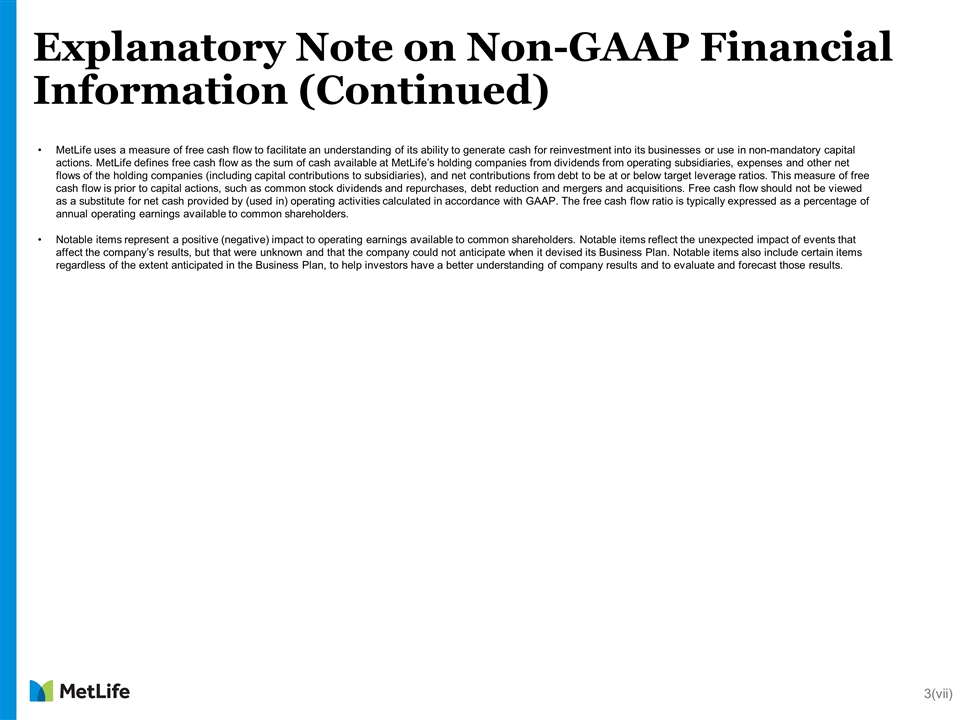
Explanatory Note on Non-GAAP Financial Information (Continued) MetLife uses a measure of free cash flow to facilitate an understanding of its ability to generate cash for reinvestment into its businesses or use in non-mandatory capital actions. MetLife defines free cash flow as the sum of cash available at MetLife’s holding companies from dividends from operating subsidiaries, expenses and other net flows of the holding companies (including capital contributions to subsidiaries), and net contributions from debt to be at or below target leverage ratios. This measure of free cash flow is prior to capital actions, such as common stock dividends and repurchases, debt reduction and mergers and acquisitions. Free cash flow should not be viewed as a substitute for net cash provided by (used in) operating activities calculated in accordance with GAAP. The free cash flow ratio is typically expressed as a percentage of annual operating earnings available to common shareholders. Notable items represent a positive (negative) impact to operating earnings available to common shareholders. Notable items reflect the unexpected impact of events that affect the company’s results, but that were unknown and that the company could not anticipate when it devised its Business Plan. Notable items also include certain items regardless of the extent anticipated in the Business Plan, to help investors have a better understanding of company results and to evaluate and forecast those results. 3(vii)

Agenda Overview Steven A. Kandarian, Chairman, President & Chief Executive Officer U.S. Michel Khalaf, President, U.S. Business and Europe, Middle East and Africa 3. Asia Steven J. Goulart, Executive Vice President, Chief Investment Officer & Interim Head of Asia 4. Latin America Oscar Schmidt, Executive Vice President, Latin America EMEA Michel Khalaf, President, U.S. Business and Europe, Middle East and Africa MetLife Holdings Marty Lippert, Executive Vice President, Head of Global Technology and Operations Financial Update John C. R. Hele, Chief Financial Officer Q&A 4
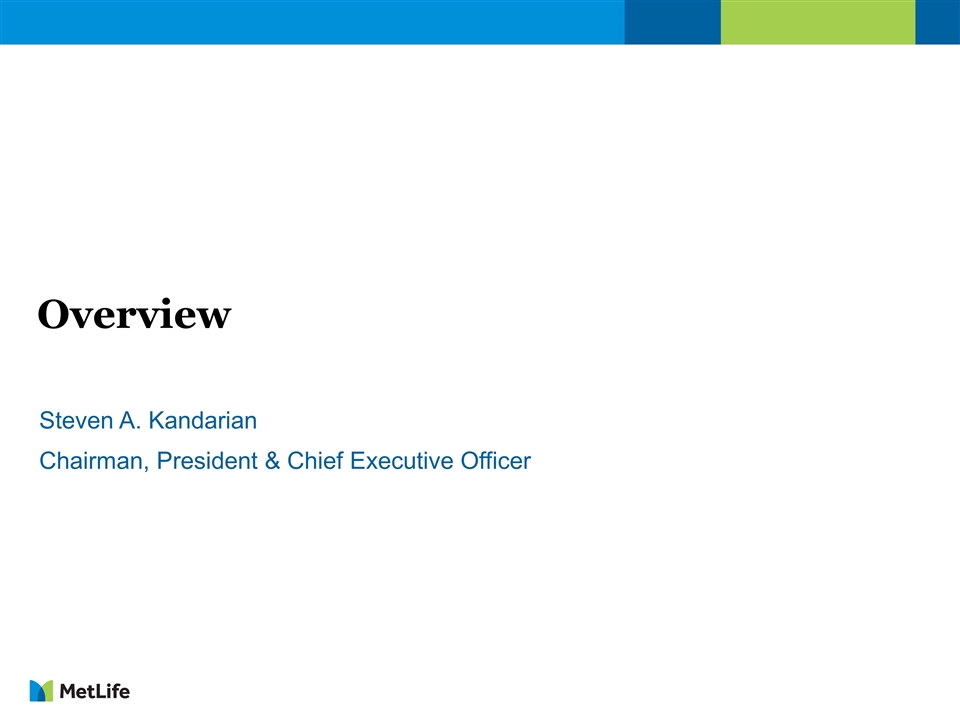
Overview Steven A. Kandarian Chairman, President & Chief Executive Officer
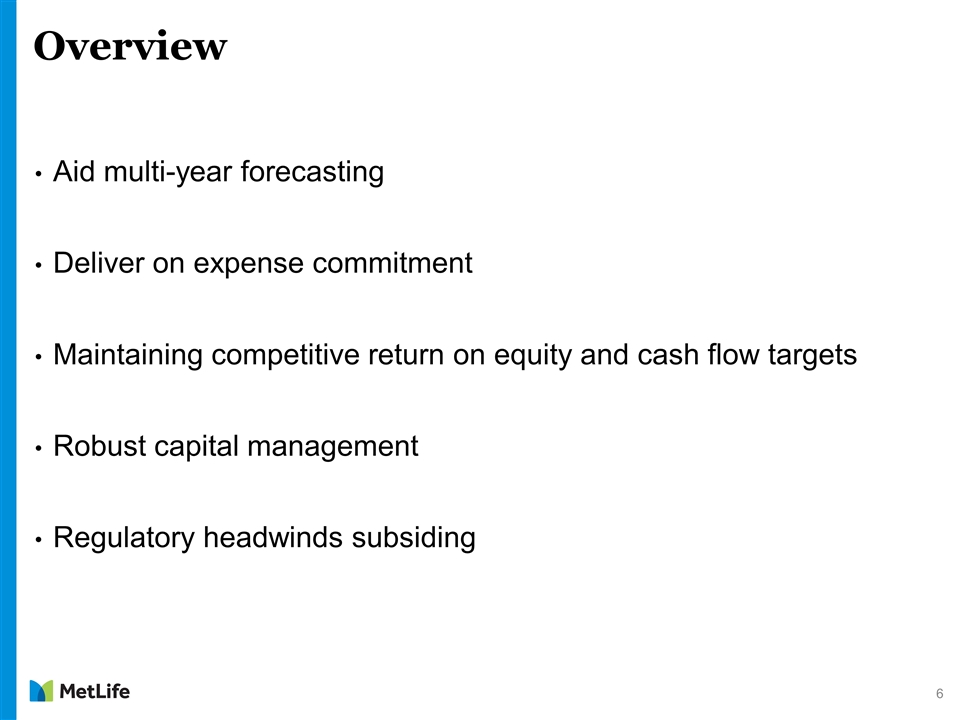
Aid multi-year forecasting Deliver on expense commitment Maintaining competitive return on equity and cash flow targets Robust capital management Regulatory headwinds subsiding 6 Overview
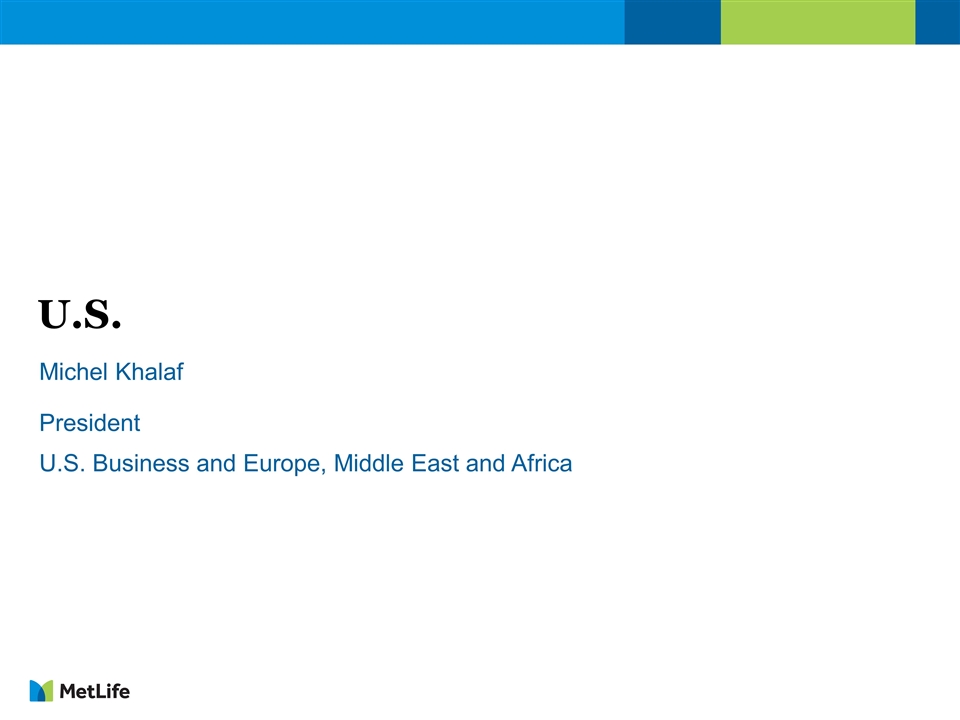
U.S. Michel Khalaf President U.S. Business and Europe, Middle East and Africa
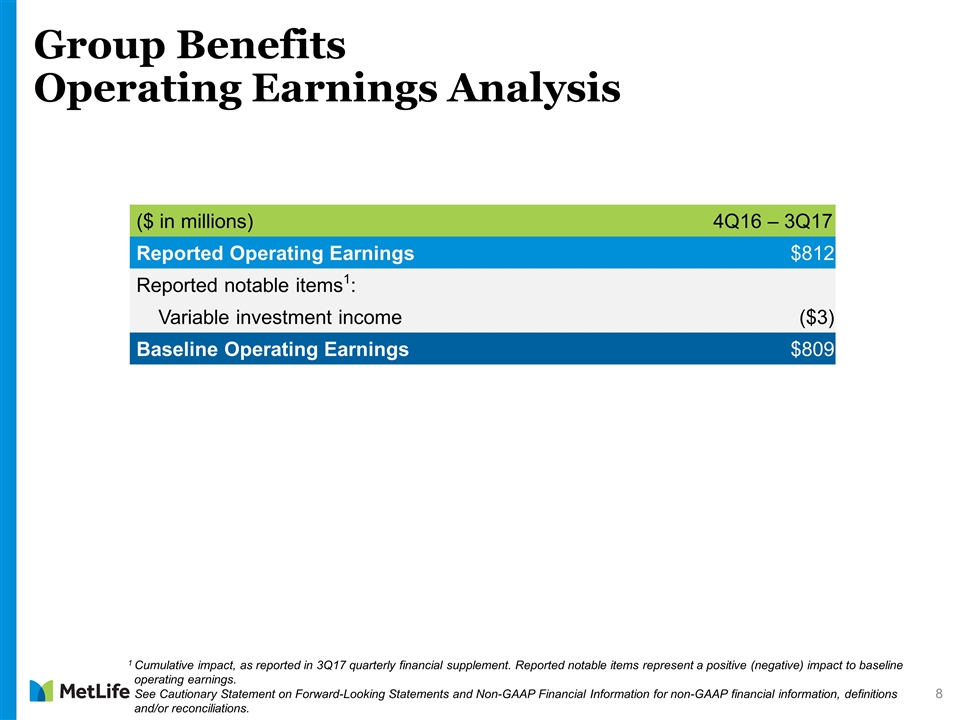
Group Benefits Operating Earnings Analysis ($ in millions) 4Q16 – 3Q17 Reported Operating Earnings $812 Reported notable items1: Variable investment income ($3) Baseline Operating Earnings $809 1 Cumulative impact, as reported in 3Q17 quarterly financial supplement. Reported notable items represent a positive (negative) impact to baseline operating earnings. See Cautionary Statement on Forward-Looking Statements and Non-GAAP Financial Information for non-GAAP financial information, definitions and/or reconciliations. 8
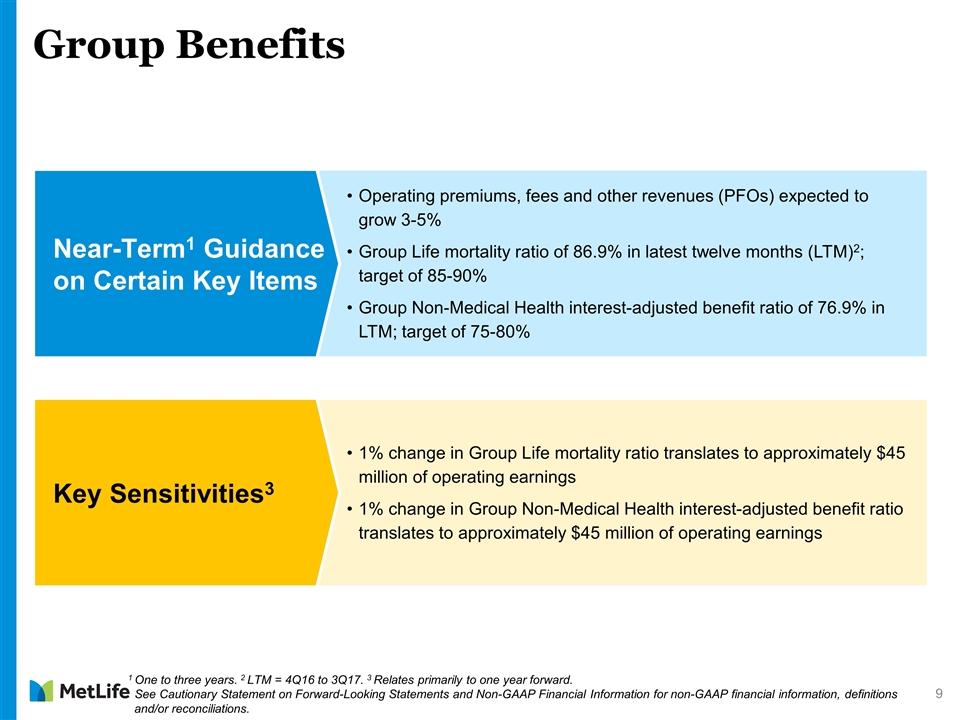
Group Benefits 1 One to three years. 2 LTM = 4Q16 to 3Q17. 3 Relates primarily to one year forward. See Cautionary Statement on Forward-Looking Statements and Non-GAAP Financial Information for non-GAAP financial information, definitions and/or reconciliations. 9 Operating premiums, fees and other revenues (PFOs) expected to grow 3-5% Group Life mortality ratio of 86.9% in latest twelve months (LTM)2; target of 85-90% Group Non-Medical Health interest-adjusted benefit ratio of 76.9% in LTM; target of 75-80% Near-Term1 Guidance on Certain Key Items 1% change in Group Life mortality ratio translates to approximately $45 million of operating earnings 1% change in Group Non-Medical Health interest-adjusted benefit ratio translates to approximately $45 million of operating earnings Key Sensitivities3
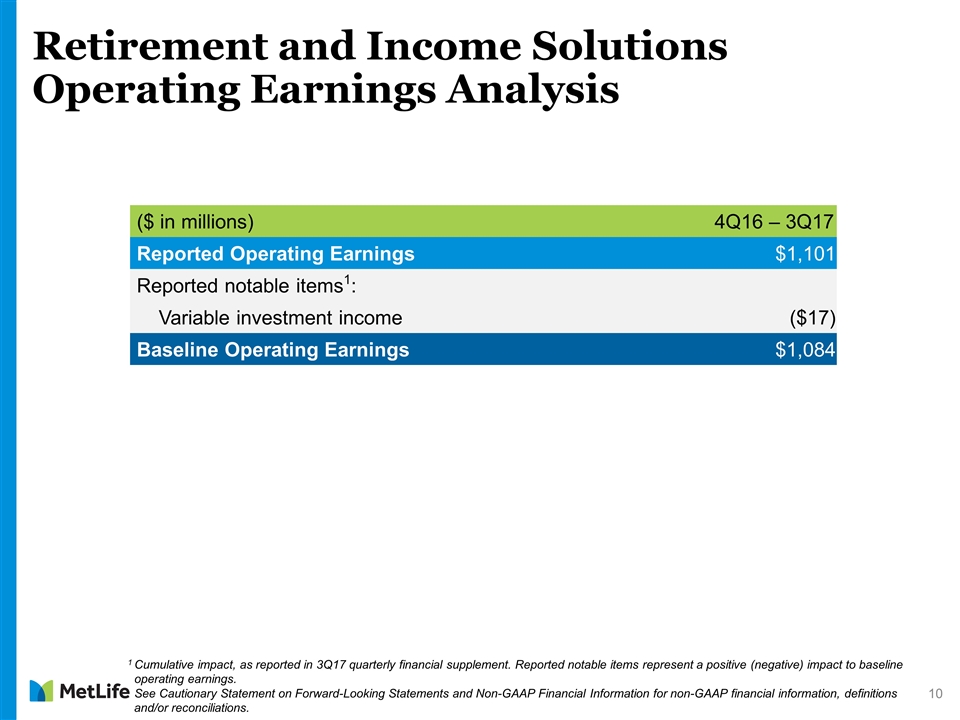
Retirement and Income Solutions Operating Earnings Analysis ($ in millions) 4Q16 – 3Q17 Reported Operating Earnings $1,101 Reported notable items1: Variable investment income ($17) Baseline Operating Earnings $1,084 1 Cumulative impact, as reported in 3Q17 quarterly financial supplement. Reported notable items represent a positive (negative) impact to baseline operating earnings. See Cautionary Statement on Forward-Looking Statements and Non-GAAP Financial Information for non-GAAP financial information, definitions and/or reconciliations. 10
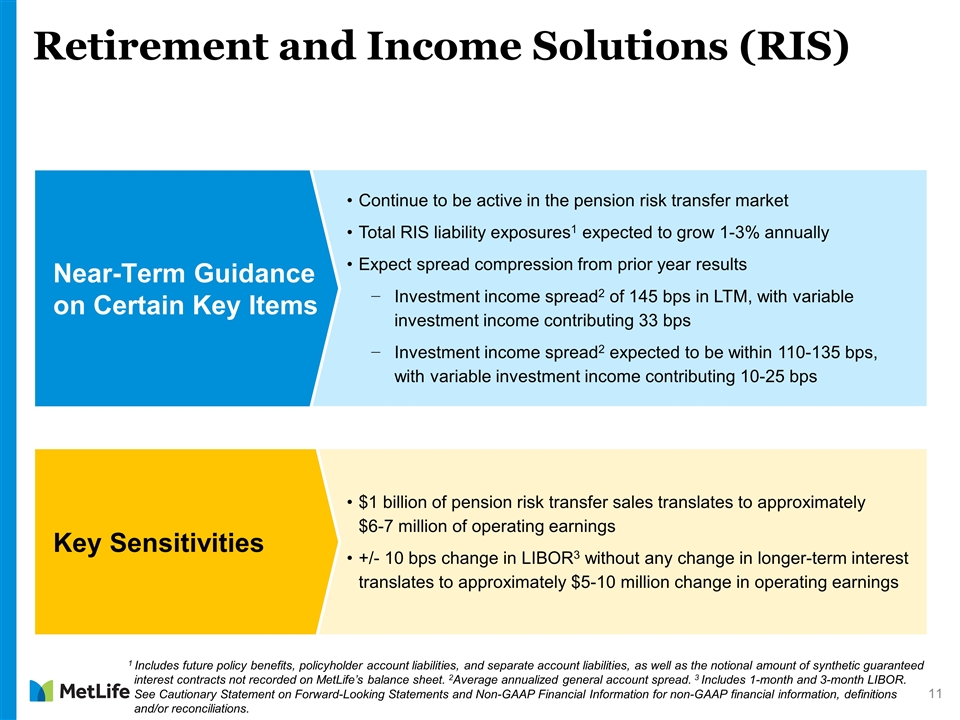
11 Retirement and Income Solutions (RIS) 1 Includes future policy benefits, policyholder account liabilities, and separate account liabilities, as well as the notional amount of synthetic guaranteed interest contracts not recorded on MetLife’s balance sheet. 2Average annualized general account spread. 3 Includes 1-month and 3-month LIBOR. See Cautionary Statement on Forward-Looking Statements and Non-GAAP Financial Information for non-GAAP financial information, definitions and/or reconciliations. Continue to be active in the pension risk transfer market Total RIS liability exposures1 expected to grow 1-3% annually Expect spread compression from prior year results Investment income spread2 of 145 bps in LTM, with variable investment income contributing 33 bps Investment income spread2 expected to be within 110-135 bps, with variable investment income contributing 10-25 bps Near-Term Guidance on Certain Key Items $1 billion of pension risk transfer sales translates to approximately $6-7 million of operating earnings +/- 10 bps change in LIBOR3 without any change in longer-term interest translates to approximately $5-10 million change in operating earnings Key Sensitivities
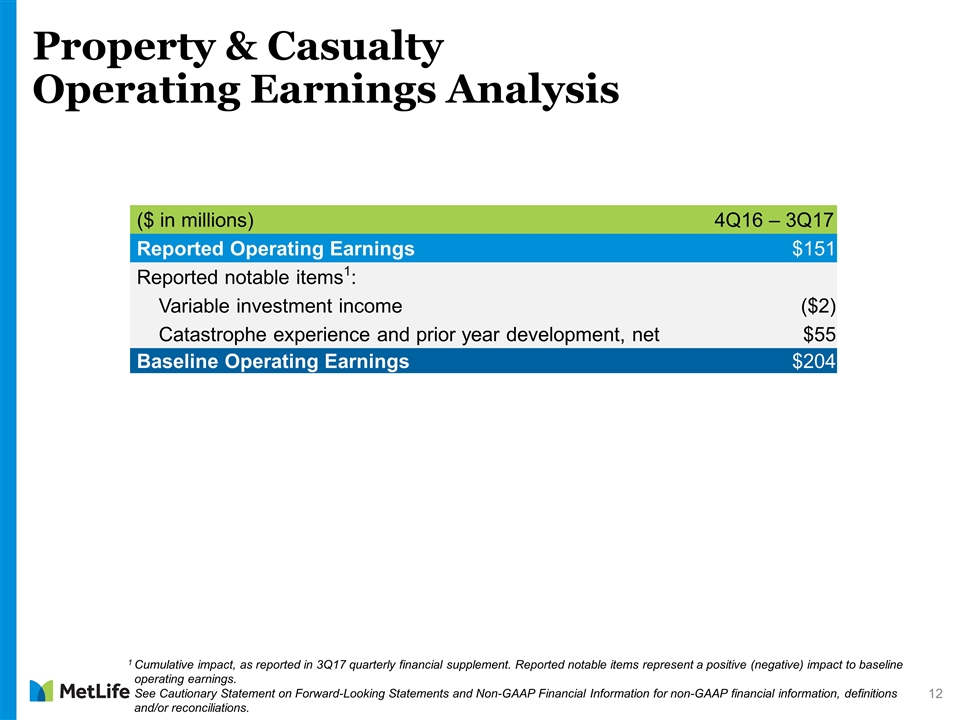
($ in millions) 4Q16 – 3Q17 Reported Operating Earnings $151 Reported notable items1: Variable investment income ($2) Catastrophe experience and prior year development, net $55 Baseline Operating Earnings $204 Property & Casualty Operating Earnings Analysis 1 Cumulative impact, as reported in 3Q17 quarterly financial supplement. Reported notable items represent a positive (negative) impact to baseline operating earnings. See Cautionary Statement on Forward-Looking Statements and Non-GAAP Financial Information for non-GAAP financial information, definitions and/or reconciliations. 12
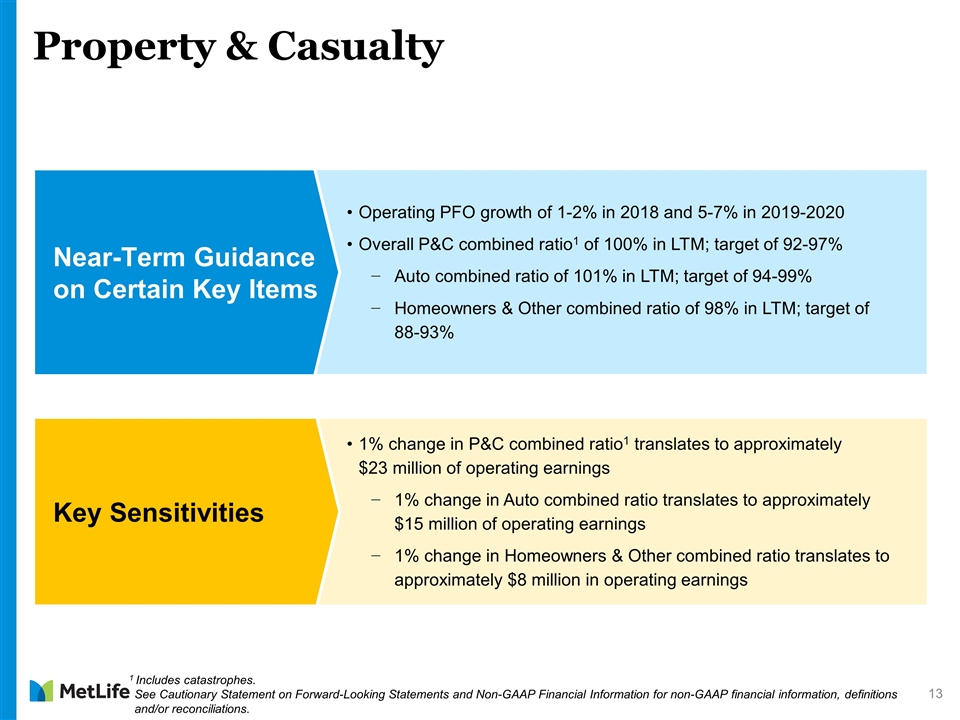
Property & Casualty 13 1 Includes catastrophes. See Cautionary Statement on Forward-Looking Statements and Non-GAAP Financial Information for non-GAAP financial information, definitions and/or reconciliations. Operating PFO growth of 1-2% in 2018 and 5-7% in 2019-2020 Overall P&C combined ratio1 of 100% in LTM; target of 92-97% Auto combined ratio of 101% in LTM; target of 94-99% Homeowners & Other combined ratio of 98% in LTM; target of 88-93% Near-Term Guidance on Certain Key Items 1% change in P&C combined ratio1 translates to approximately $23 million of operating earnings 1% change in Auto combined ratio translates to approximately $15 million of operating earnings 1% change in Homeowners & Other combined ratio translates to approximately $8 million in operating earnings Key Sensitivities
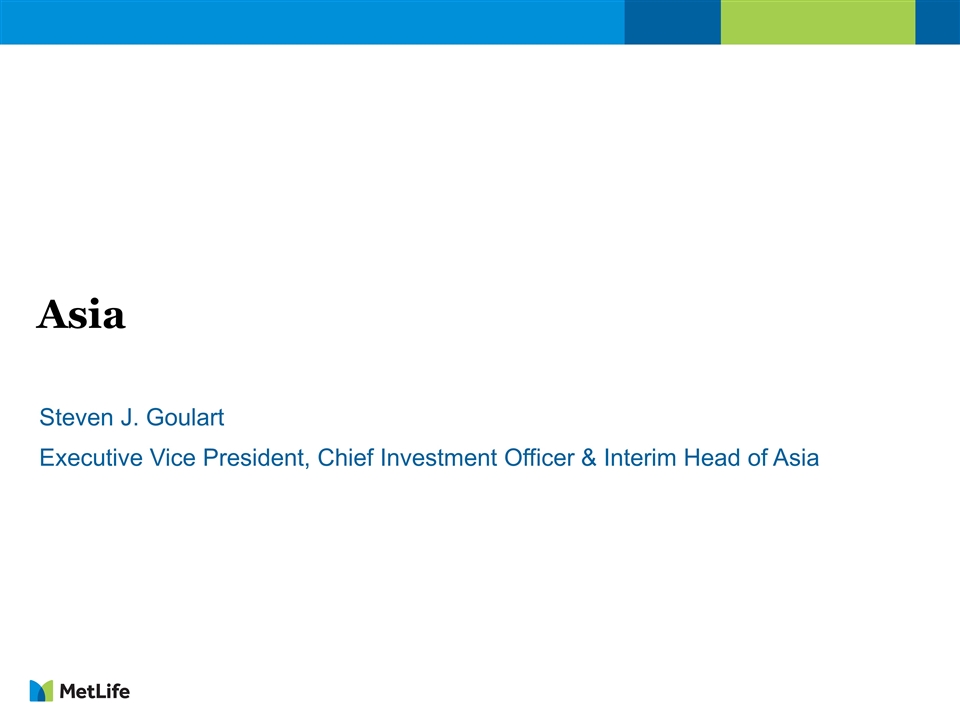
Asia Steven J. Goulart Executive Vice President, Chief Investment Officer & Interim Head of Asia
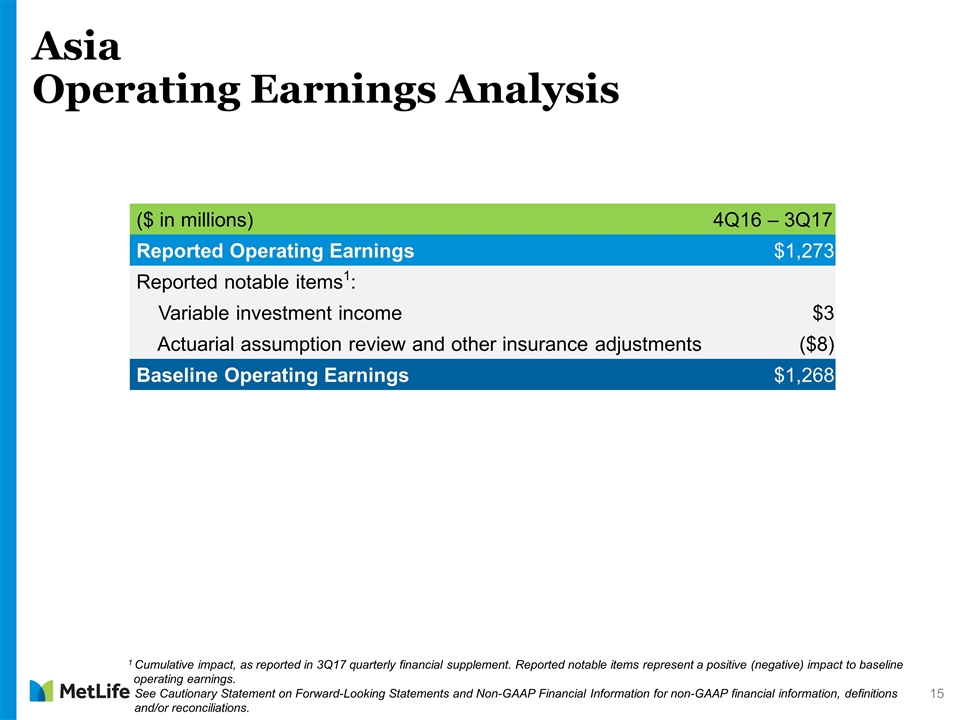
($ in millions) 4Q16 – 3Q17 Reported Operating Earnings $1,273 Reported notable items1: Variable investment income $3 Actuarial assumption review and other insurance adjustments ($8) Baseline Operating Earnings $1,268 Asia Operating Earnings Analysis 1 Cumulative impact, as reported in 3Q17 quarterly financial supplement. Reported notable items represent a positive (negative) impact to baseline operating earnings. See Cautionary Statement on Forward-Looking Statements and Non-GAAP Financial Information for non-GAAP financial information, definitions and/or reconciliations. 15
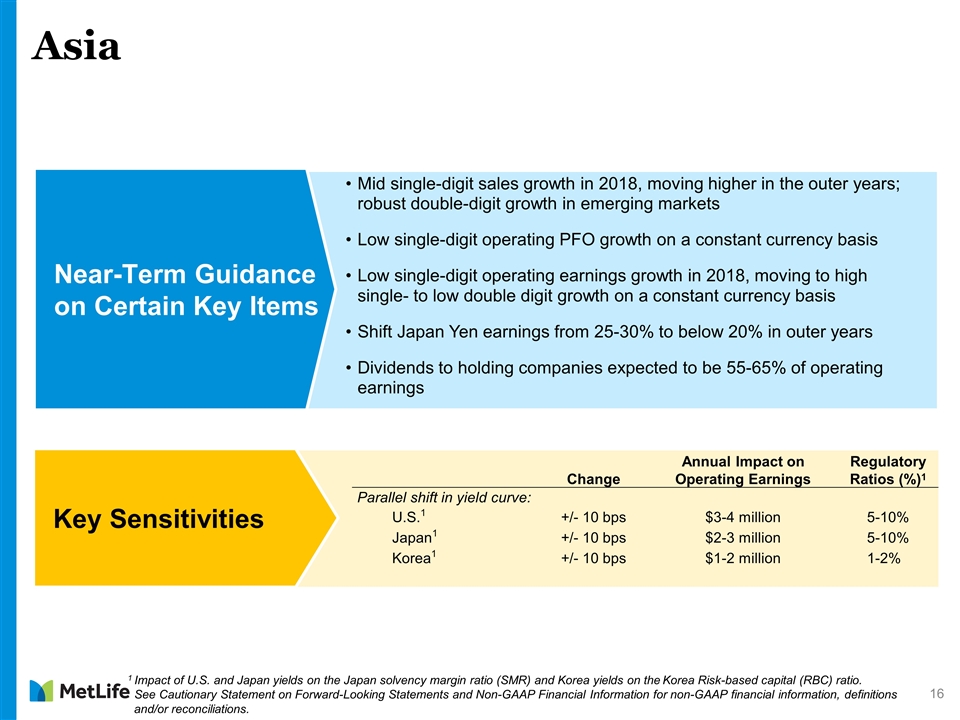
Mid single-digit sales growth in 2018, moving higher in the outer years; robust double-digit growth in emerging markets Low single-digit operating PFO growth on a constant currency basis Low single-digit operating earnings growth in 2018, moving to high single- to low double digit growth on a constant currency basis Shift Japan Yen earnings from 25-30% to below 20% in outer years Dividends to holding companies expected to be 55-65% of operating earnings Asia 1 Impact of U.S. and Japan yields on the Japan solvency margin ratio (SMR) and Korea yields on the Korea Risk-based capital (RBC) ratio. See Cautionary Statement on Forward-Looking Statements and Non-GAAP Financial Information for non-GAAP financial information, definitions and/or reconciliations. 16 Near-Term Guidance on Certain Key Items Change Annual Impact on Operating Earnings Regulatory Ratios (%)1 Parallel shift in yield curve: U.S.1 +/- 10 bps $3-4 million 5-10% Japan1 +/- 10 bps $2-3 million 5-10% Korea1 +/- 10 bps $1-2 million 1-2% Key Sensitivities
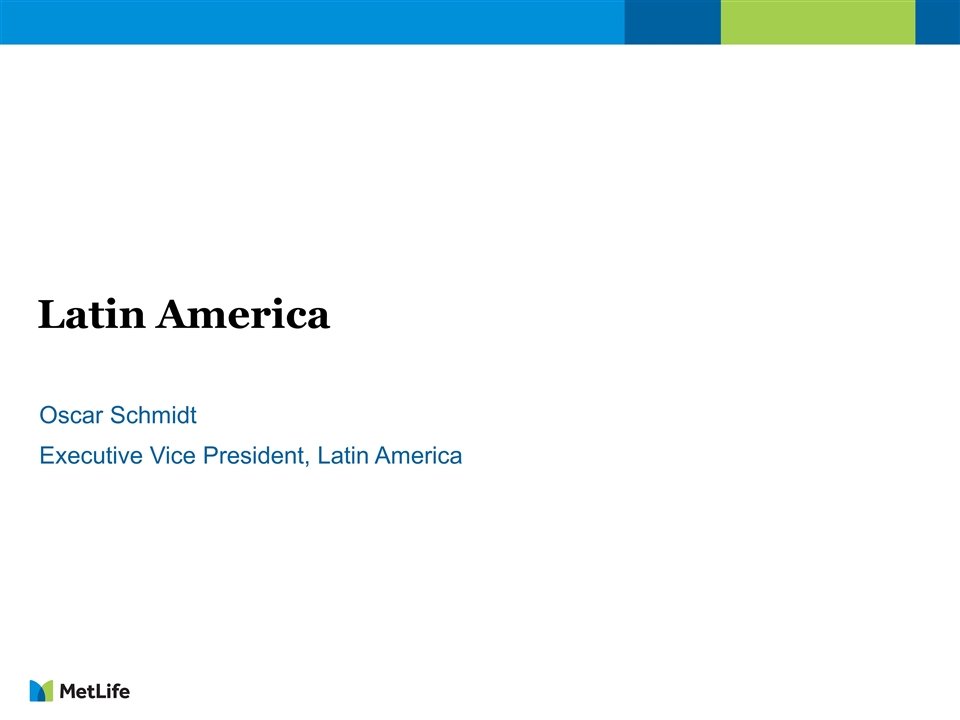
Latin America Oscar Schmidt Executive Vice President, Latin America
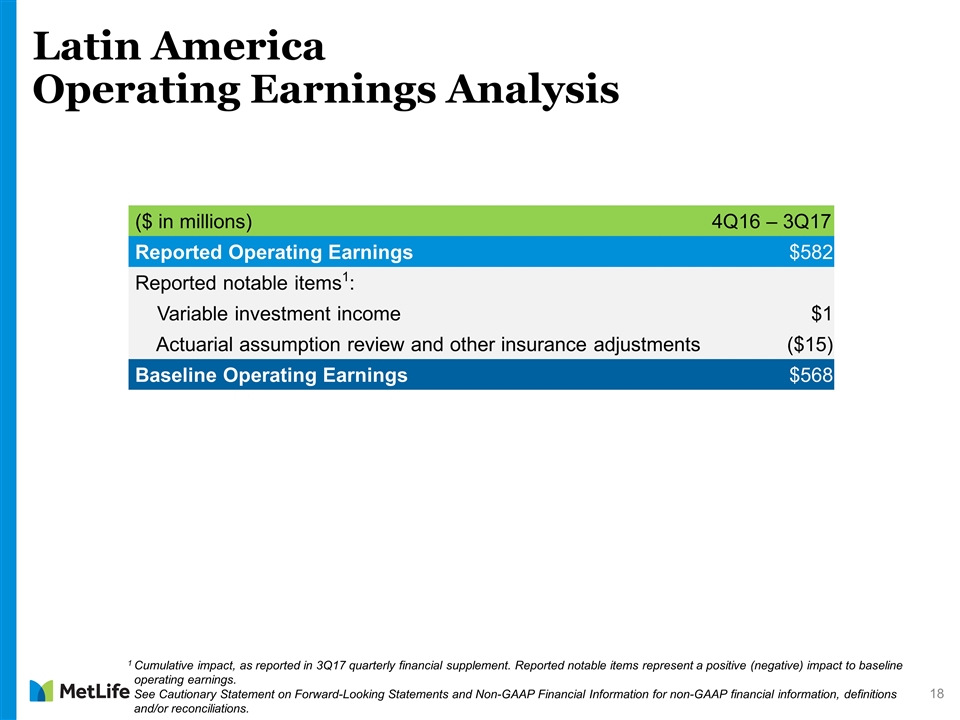
Latin America Operating Earnings Analysis 1 Cumulative impact, as reported in 3Q17 quarterly financial supplement. Reported notable items represent a positive (negative) impact to baseline operating earnings. See Cautionary Statement on Forward-Looking Statements and Non-GAAP Financial Information for non-GAAP financial information, definitions and/or reconciliations. ($ in millions) 4Q16 – 3Q17 Reported Operating Earnings $582 Reported notable items1: Variable investment income $1 Actuarial assumption review and other insurance adjustments ($15) Baseline Operating Earnings $568 18
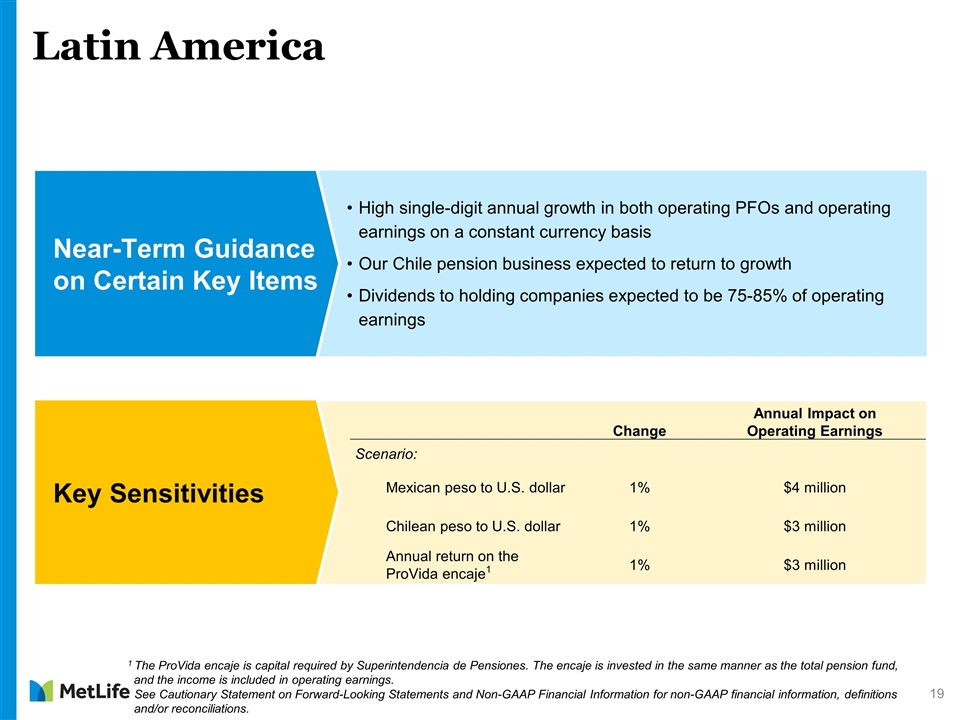
Latin America 19 1 The ProVida encaje is capital required by Superintendencia de Pensiones. The encaje is invested in the same manner as the total pension fund, and the income is included in operating earnings. See Cautionary Statement on Forward-Looking Statements and Non-GAAP Financial Information for non-GAAP financial information, definitions and/or reconciliations. High single-digit annual growth in both operating PFOs and operating earnings on a constant currency basis Our Chile pension business expected to return to growth Dividends to holding companies expected to be 75-85% of operating earnings Near-Term Guidance on Certain Key Items Change Annual Impact on Operating Earnings Scenario: Mexican peso to U.S. dollar 1% $4 million Chilean peso to U.S. dollar 1% $3 million Annual return on the ProVida encaje1 1% $3 million Key Sensitivities
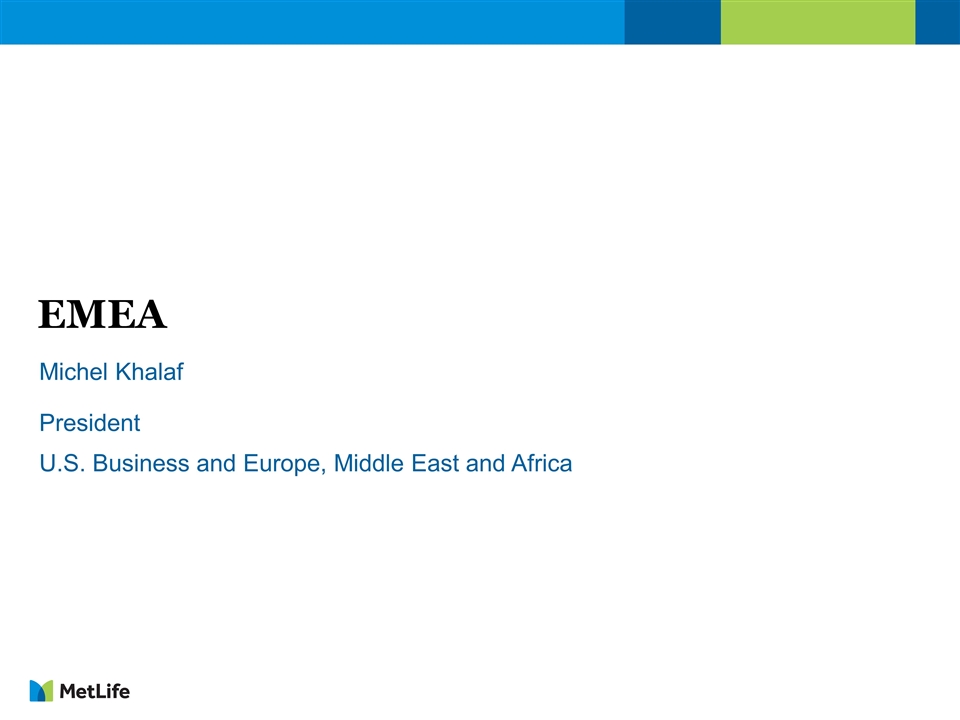
EMEA Michel Khalaf President U.S. Business and Europe, Middle East and Africa
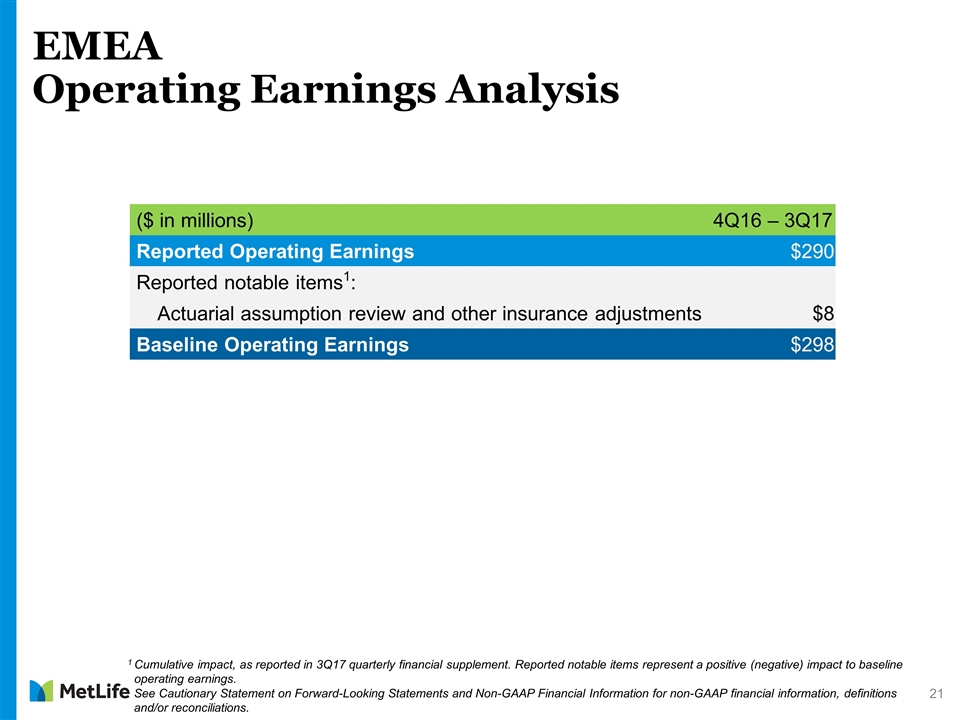
EMEA Operating Earnings Analysis 1 Cumulative impact, as reported in 3Q17 quarterly financial supplement. Reported notable items represent a positive (negative) impact to baseline operating earnings. See Cautionary Statement on Forward-Looking Statements and Non-GAAP Financial Information for non-GAAP financial information, definitions and/or reconciliations. 21 ($ in millions) 4Q16 – 3Q17 Reported Operating Earnings $290 Reported notable items1: Actuarial assumption review and other insurance adjustments $8 Baseline Operating Earnings $298
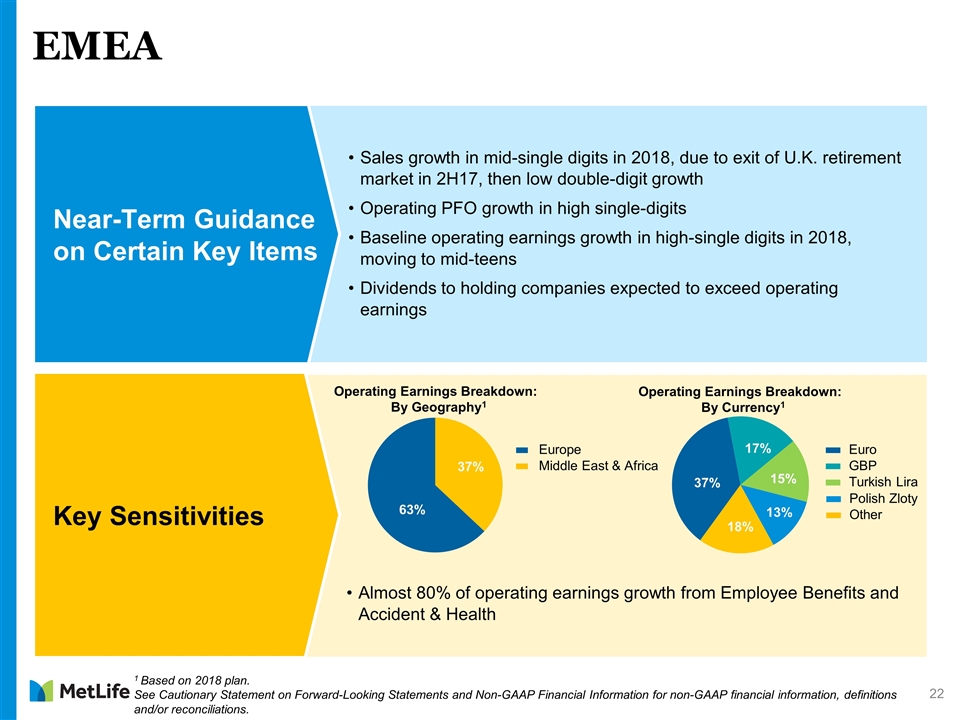
Almost 80% of operating earnings growth from Employee Benefits and Accident & Health EMEA 1 Based on 2018 plan. See Cautionary Statement on Forward-Looking Statements and Non-GAAP Financial Information for non-GAAP financial information, definitions and/or reconciliations. 22 Sales growth in mid-single digits in 2018, due to exit of U.K. retirement market in 2H17, then low double-digit growth Operating PFO growth in high single-digits Baseline operating earnings growth in high-single digits in 2018, moving to mid-teens Dividends to holding companies expected to exceed operating earnings Near-Term Guidance on Certain Key Items Key Sensitivities Middle East & Africa Europe Other Polish Zloty 63% Operating Earnings Breakdown: By Geography1 Operating Earnings Breakdown: By Currency1 Turkish Lira GBP Euro
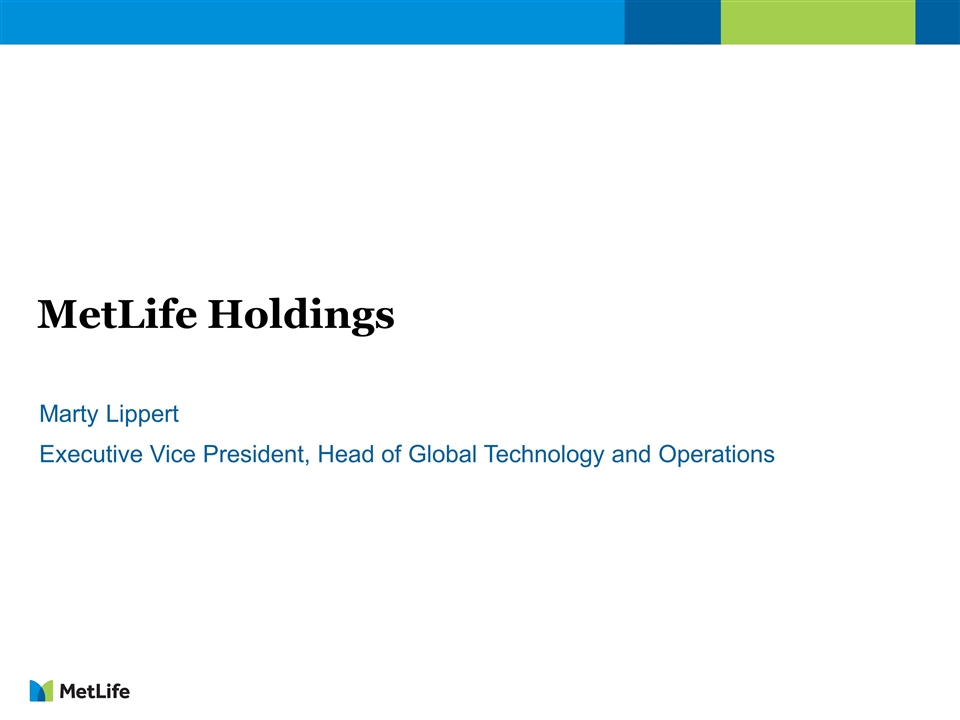
MetLife Holdings Marty Lippert Executive Vice President, Head of Global Technology and Operations
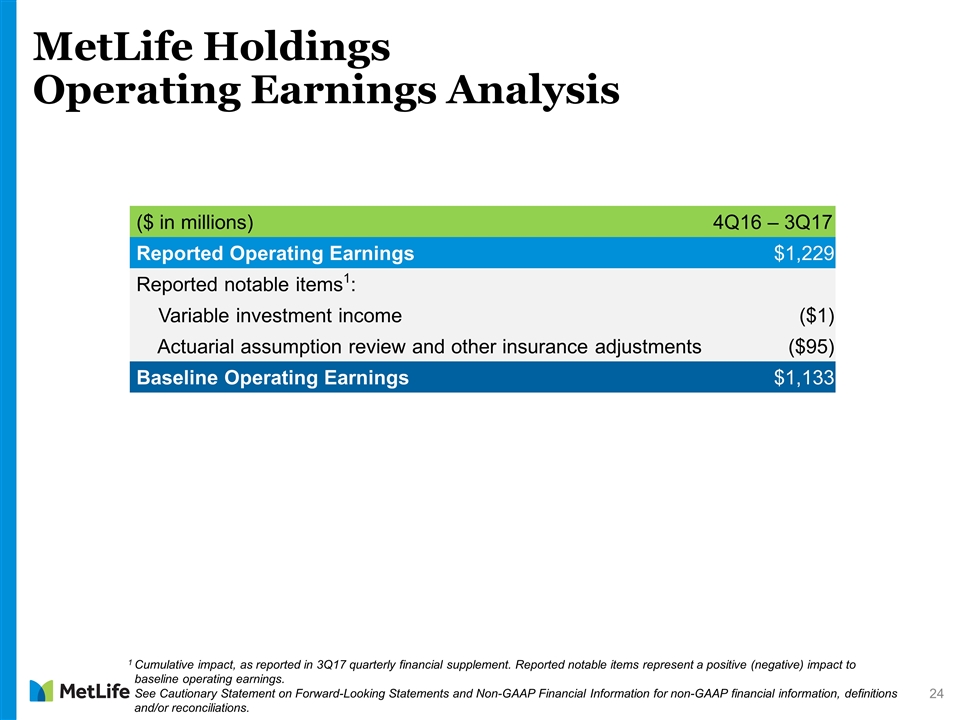
MetLife Holdings Operating Earnings Analysis 1 Cumulative impact, as reported in 3Q17 quarterly financial supplement. Reported notable items represent a positive (negative) impact to baseline operating earnings. See Cautionary Statement on Forward-Looking Statements and Non-GAAP Financial Information for non-GAAP financial information, definitions and/or reconciliations. 24 ($ in millions) 4Q16 – 3Q17 Reported Operating Earnings $1,229 Reported notable items1: Variable investment income ($1) Actuarial assumption review and other insurance adjustments ($95) Baseline Operating Earnings $1,133
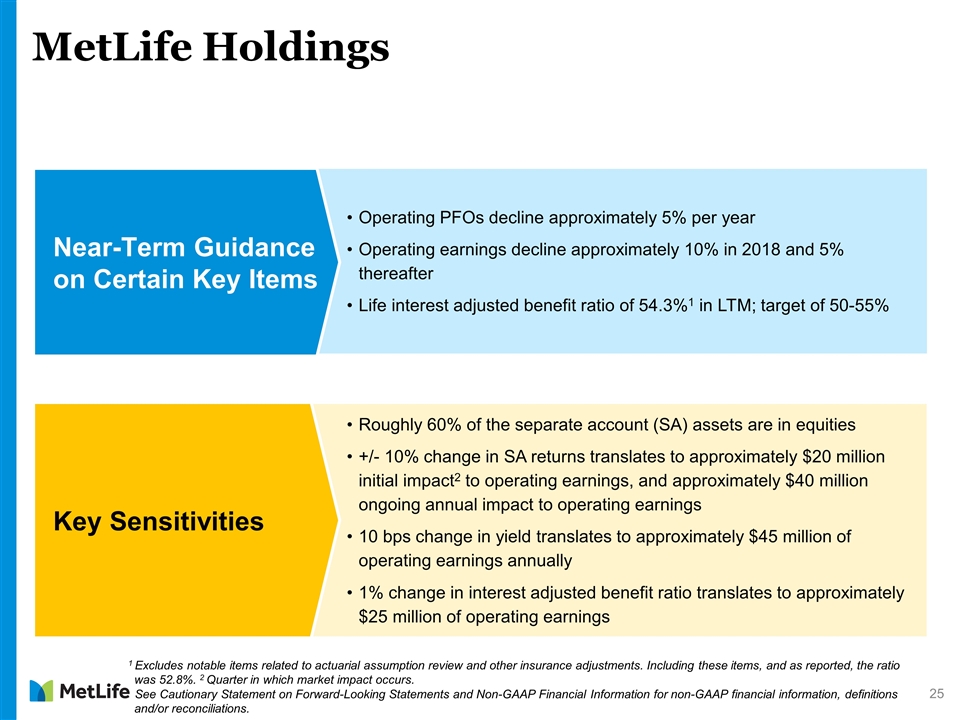
MetLife Holdings 1 Excludes notable items related to actuarial assumption review and other insurance adjustments. Including these items, and as reported, the ratio was 52.8%. 2 Quarter in which market impact occurs. See Cautionary Statement on Forward-Looking Statements and Non-GAAP Financial Information for non-GAAP financial information, definitions and/or reconciliations. 25 Operating PFOs decline approximately 5% per year Operating earnings decline approximately 10% in 2018 and 5% thereafter Life interest adjusted benefit ratio of 54.3%1 in LTM; target of 50-55% Near-Term Guidance on Certain Key Items Roughly 60% of the separate account (SA) assets are in equities +/- 10% change in SA returns translates to approximately $20 million initial impact2 to operating earnings, and approximately $40 million ongoing annual impact to operating earnings 10 bps change in yield translates to approximately $45 million of operating earnings annually 1% change in interest adjusted benefit ratio translates to approximately $25 million of operating earnings Key Sensitivities

Financial Update John C. R. Hele Chief Financial Officer
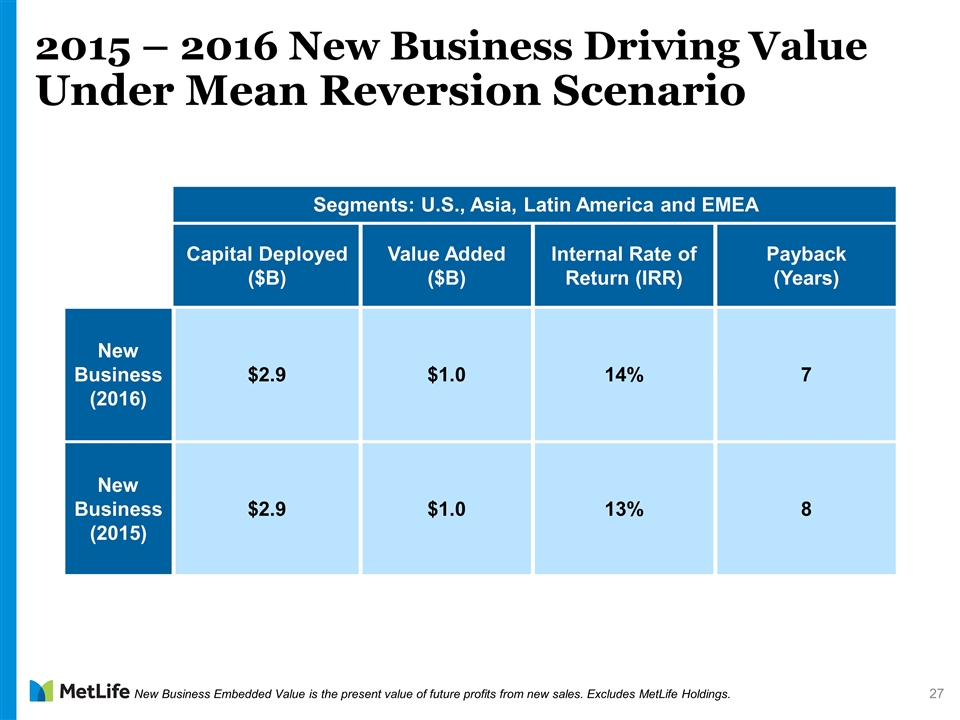
2015 – 2016 New Business Driving Value Under Mean Reversion Scenario New Business Embedded Value is the present value of future profits from new sales. Excludes MetLife Holdings. Segments: U.S., Asia, Latin America and EMEA Capital Deployed ($B) Value Added ($B) Internal Rate of Return (IRR) Payback (Years) New Business (2016) $2.9 $1.0 14% 7 New Business (2015) $2.9 $1.0 13% 8 27

91% of 2016 Capital Deployed Above Hurdle Rate Under Mean Reversion Scenario 2016 New Business Segments: U.S., Asia, Latin America and EMEA IRR above hurdle rate (4+%) IRR above hurdle rate (0-4%) IRR below hurdle rate Business Units Excludes MetLife Holdings. Capital Deployed IRR Above Hurdle Rate 28
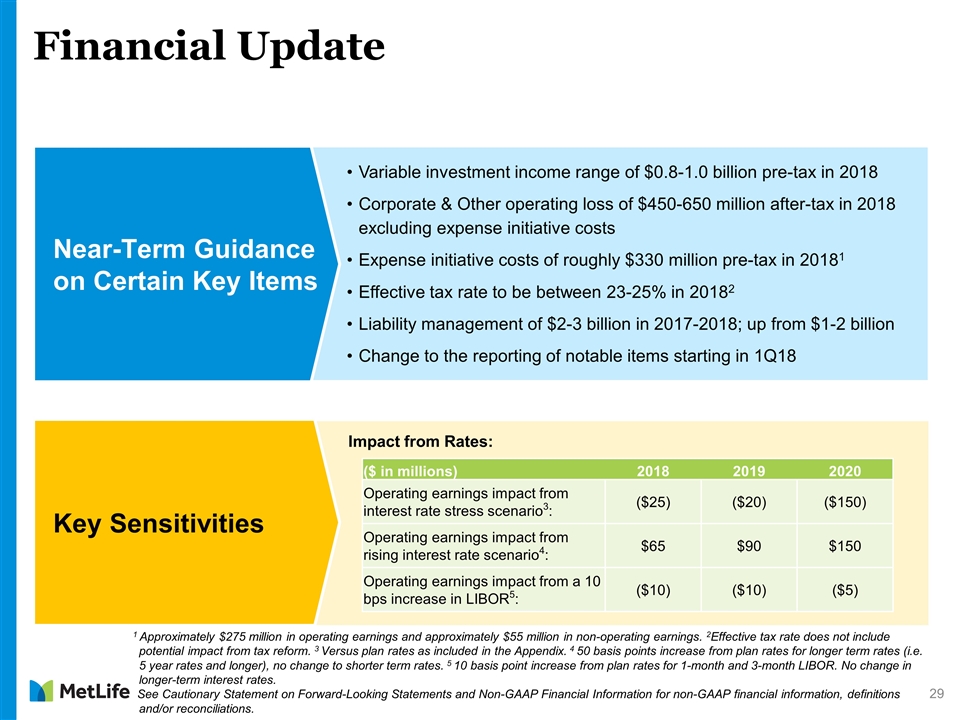
Financial Update 1 Approximately $275 million in operating earnings and approximately $55 million in non-operating earnings. 2Effective tax rate does not include potential impact from tax reform. 3 Versus plan rates as included in the Appendix. 4 50 basis points increase from plan rates for longer term rates (i.e. 5 year rates and longer), no change to shorter term rates. 5 10 basis point increase from plan rates for 1-month and 3-month LIBOR. No change in longer-term interest rates. See Cautionary Statement on Forward-Looking Statements and Non-GAAP Financial Information for non-GAAP financial information, definitions and/or reconciliations. 29 Variable investment income range of $0.8-1.0 billion pre-tax in 2018 Corporate & Other operating loss of $450-650 million after-tax in 2018 excluding expense initiative costs Expense initiative costs of roughly $330 million pre-tax in 20181 Effective tax rate to be between 23-25% in 20182 Liability management of $2-3 billion in 2017-2018; up from $1-2 billion Change to the reporting of notable items starting in 1Q18 Near-Term Guidance on Certain Key Items Impact from Rates: Key Sensitivities ($ in millions) 2018 2019 2020 Operating earnings impact from interest rate stress scenario3: ($25) ($20) ($150) Operating earnings impact from rising interest rate scenario4: $65 $90 $150 Operating earnings impact from a 10 bps increase in LIBOR5: ($10) ($10) ($5)

Appendix
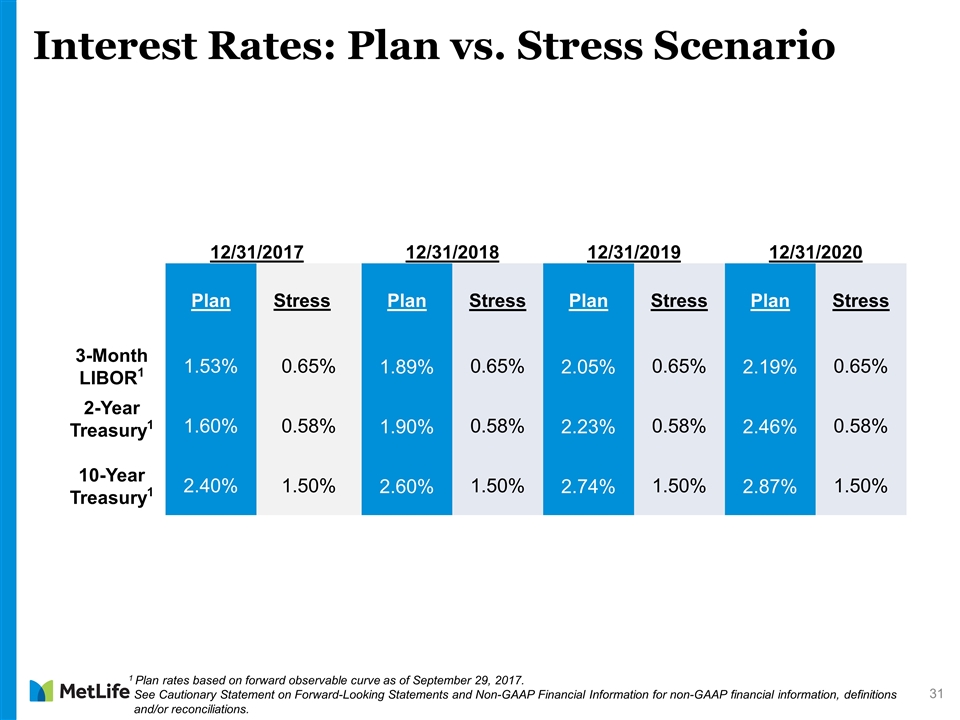
Interest Rates: Plan vs. Stress Scenario 12/31/2017 12/31/2018 12/31/2019 12/31/2020 Plan Stress Plan Stress Plan Stress Plan Stress 3-Month LIBOR1 1.53% 0.65% 1.89% 0.65% 2.05% 0.65% 2.19% 0.65% 2-Year Treasury1 1.60% 0.58% 1.90% 0.58% 2.23% 0.58% 2.46% 0.58% 10-Year Treasury1 2.40% 1.50% 2.60% 1.50% 2.74% 1.50% 2.87% 1.50% 1 Plan rates based on forward observable curve as of September 29, 2017. See Cautionary Statement on Forward-Looking Statements and Non-GAAP Financial Information for non-GAAP financial information, definitions and/or reconciliations. 31
